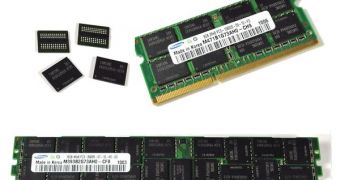Samsung's 40nm Green DDR3 is especially designed to enhance power efficiency for servers looking to comply with or surpass the Energy Start specifications. As the first to bring 4Gb DDR3 devices based on the 40nm process technology, Samsung seeks to enable significant power savings in data centers, high-end notebooks and server systems. Power consumption is not the only benefit of the modules, however, as the 4Gb DDR3 also doubles the maximum data density when compared with 2Gb devices.
Today's servers are equipped with six registered dual in-line memory modules (RDIMMs) per CPU, on average, which enables a DRAM capacity of up to 96GB. Depending on the components, power consumption can range between 210W, in the case of 60nm-class 1Gb DDR2, and 55W, in the case of the 40nm 2Gb DDR3 module. This shows power savings of about 75%. However, while impressive, this power efficiency is outmatched by the new 4Gb DDR3, which only uses up 36W, or 83% less than the 60nm-class 1Gb DDR2 module. Overall, this corresponds to a server power reduction of 10% per system.
“When our 40nm-class DDR3 was first introduced last July, we were well ahead of the curve for high density, high performance DDR3,” Dong-Soo Jun, executive vice president, memory marketing, Samsung Electronics, said. “Now, in just seven more months, we have introduced an ultra-low power ‘Green Memory’ – the 4Gb DDR3, which is double the density of its predecessor. At a module density of 16-gigabyte (GB), the 4Gb based module can save 35 percent in power consumption, to support customer requirements for more energy-efficient designs.”
In addition to power efficiency, adding 40nm 4Gb DDR3 to existing servers will sharply extend system lifetime and raise DRAM density at least two-fold. This is possible because the 4Gb DDR3 raises the SoDIMM (small outline dual inline memory module) density to 8GB. This allows for a system density of 16GB (in two-socket modes) and 32GB (for four-socket modes). Of course, such a high density will benefit not only serves and data centers, but also high-end notebooks with advanced graphics.
Samsung aims to migrate more than 90 percent of its DDR DRAM production to the 40nm-class process technology. The 4Gb DDR3 supports both 1.25V and 1.35V specifications and enables memory modules of 16GB and 32GB (for RDIMMs) and 8GB SoDIMMs with a performance rate of 1.6 Gbps. Information on the company's Green DDR3 may be found on the official website.

 14 DAY TRIAL //
14 DAY TRIAL //